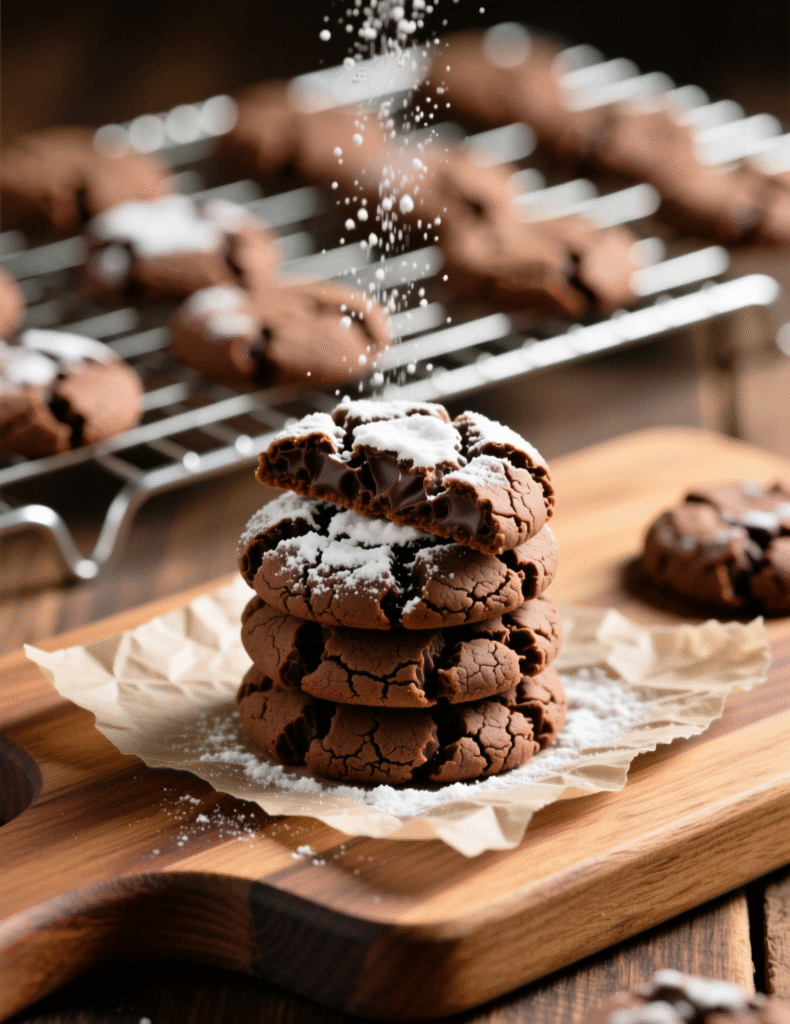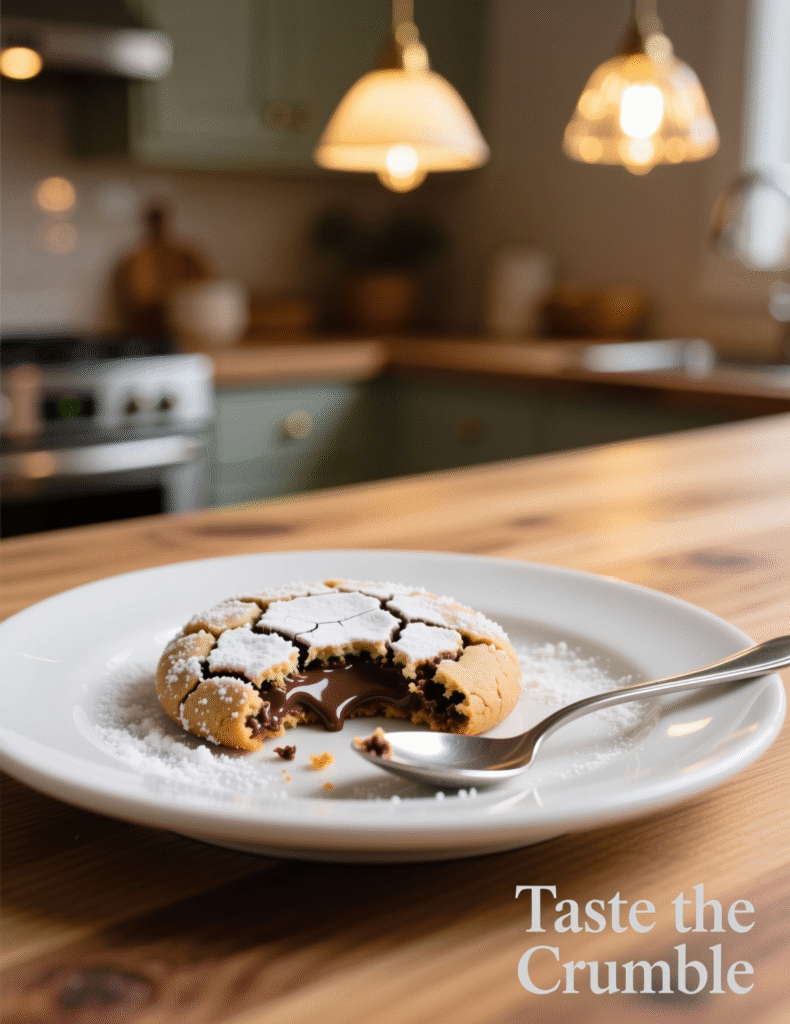The first time you see a tray of chocolate crinkle cookies come out of the oven, it feels a little magical. The tops split like cracked earth, sugar crusted into snowy ridges, hiding the gooey middle beneath. For a recipe so widely loved, there’s a surprising amount of science tucked into every bite. This isn’t just a fun cookie. It’s a study in contrasts—crisp shell, chewy interior, bitter cocoa balanced with powdered sugar. And if you’re aiming for professional-level execution, every detail matters.
Why Chocolate Crinkle Cookies Stand Out
These cookies are different from your standard chocolate chip or oatmeal raisin. They lean on cocoa powder rather than melted chocolate, which means the flavor is intense without being cloying. Unlike drop cookies, crinkles rely on chilling the dough. That’s not just for convenience—it controls spread, ensures depth of flavor, and creates the fissures that make them instantly recognizable.
In professional kitchens, visual appeal is as important as flavor. A cookie with cracks running wildly across its top tells you that the baker understood timing, temperature, and dough consistency. Miss one, and you get flat discs without the signature texture.
The Science of the Crinkle
Why do they crack at all? The secret lies in contrast. The outer layer of dough sets quickly in the oven, coated in powdered sugar, while the inside expands and pushes through. As steam builds and gases from baking powder release, the surface fractures. This is no accident—it’s chemistry harnessed for beauty.
A 2019 study on cookie spread by food scientists in the Journal of Food Engineering showed that fat distribution and hydration directly affect fissure formation. Too much liquid and the dough won’t firm enough. Too little fat and cracks won’t open properly. Professionals know to watch hydration like hawks.
Ingredients Breakdown: More Than Just a List
Here’s what you’ll need for 24 servings, but let’s talk beyond grams and cups. Every ingredient is doing more work than it seems.
- 1 cup unsweetened cocoa powder (deep flavor, dry base that needs fat)
- 2 cups granulated sugar (sweetness, but also structure)
- ½ cup vegetable oil (neutral fat, coats cocoa particles better than butter)
- 4 large eggs (emulsifier, moisture, structure builder)
- 2 teaspoons vanilla extract (aromatic compound, volatile oils enhance cocoa)
- 2 cups all-purpose flour (protein, but not too high or you’ll lose tenderness)
- 2 teaspoons baking powder (gas release, structure lifting)
- ½ teaspoon salt (flavor enhancer, balances bitterness)
- ½ cup powdered sugar (final coating, crystallization contrast)
Professionals often swap part of the oil for melted butter if richness is desired, but pure oil keeps the chew more consistent. Some bakeries even add espresso powder to deepen flavor—an old trick to intensify cocoa without shouting “coffee.”

Step-by-Step Professional Method
- Whisk cocoa, sugar, and oil. This step looks simple, but here’s the catch—oil must fully coat cocoa particles. Otherwise, the dough clumps later. Professionals mix until shiny and smooth, which can take a minute longer than you’d think.
- Beat in eggs, one at a time. Eggs create the backbone of this dough. Adding them slowly prevents curdling and ensures emulsification. If you rush it, the texture is gritty rather than glossy.
- Fold in vanilla. Vanilla isn’t just for aroma; it modifies perceived sweetness. Research has shown it tricks your palate into thinking the cookie is sweeter than it actually is.
- Mix flour, baking powder, salt separately. Dry whisking avoids uneven leavening, which can create lopsided cracks.
- Combine wet and dry. Do this gently. Overmixing encourages gluten development, which professionals avoid if they want tenderness. You want a sticky dough, not bread dough.
- Chill at least 4 hours, ideally overnight. This is the hardest part for home bakers but the most critical for professionals. Cold dough holds its shape longer in the oven, encouraging dramatic fissures.
- Scoop, roll into balls, coat heavily in powdered sugar. Too light a dusting and the sugar dissolves, leaving patches. Double coating works best in humid climates.
- Bake at 350°F for 10–12 minutes. Pull them when cracks form and centers are just set. The carry-over heat finishes them. Overbake by even two minutes, and chewiness turns into dryness.
Common Mistakes Bakers Make
Flat cookies usually mean the dough wasn’t chilled long enough. Another issue? Old baking powder. Professionals test their leavening monthly by dropping it in warm water—if it bubbles, it’s alive.
Another mistake is undercoating with powdered sugar. It’s not just for looks. The sugar helps slow the set of the outer shell, exaggerating cracks. Skimp and you lose both beauty and texture.
Variations and Professional Tweaks
Top bakeries rarely stick with the classic. They riff. Some fold in chunks of dark chocolate for molten pockets. Others roll the dough first in granulated sugar, then powdered, creating a dual crunch.
Gluten-free variations use almond flour, though the chew is less elastic. Vegan versions swap flax eggs and coconut oil, but consistency gets tricky—professional pastry chefs often add xanthan gum to mimic egg binding.
In a 2022 trend analysis by Bake Magazine, chocolate crinkle cookies ranked among the top 5 holiday classics reimagined with new flavor profiles. Think red velvet crinkles, matcha crinkles, even ube crinkles in Filipino bakeries.
Shelf Life and Storage: Professional Insight
At room temperature, these cookies last 4–5 days in airtight containers. But here’s the professional move—bake only half, freeze the rest of the dough in pre-rolled balls. They can be baked straight from frozen with just an extra 2 minutes in the oven.
Texture changes fast, so pastry shops often bake crinkles in small batches throughout the day. The aroma alone sells more than the cookie itself.
Serving and Pairing Suggestions
Crinkles are holiday staples, but they’re versatile. Paired with espresso, they highlight bitterness. With a glass of milk, sweetness dominates. At high-end restaurants, I’ve seen them plated with crème anglaise or pistachio gelato.
For a catered event, stacking them into towers dusted with extra powdered sugar creates a snowball effect. A detail as simple as sprinkling cocoa nibs over the serving platter elevates presentation.
Professional Troubleshooting
- Dough too dry? Check if your cocoa is natural vs Dutch-process. Dutch absorbs less moisture, so recipes may need adjustment.
- Sugar melting during bake? Humidity. Roll dough balls in sugar, rest 30 seconds, roll again. Professionals call it the “double dip.”
- Cracks too shallow? Oven temperature too low. Professional ovens run consistent, but home ovens can swing 15–20 degrees. Always test with a thermometer.

Why This Recipe Works
It’s a balance of precision and allowance. Professionals lean on ratios: fat to flour, sugar to liquid, leavening to weight. This recipe balances all three. The oil keeps chew, the cocoa provides structure, the eggs bind. Powdered sugar not only decorates but manipulates how the cookie opens.
Every bite is a reminder of why baking is both art and science. A professional baker doesn’t just follow a recipe. They anticipate how ingredients interact, and they adjust by feel, smell, even sound of the mixer.
Conclusion
Chocolate crinkle cookies may look simple, but they’re a technical showcase. They test a baker’s ability to manage moisture, timing, and presentation. For 24 servings, you’re not just making cookies—you’re practicing the science of crack formation, sugar crystallization, and flavor balance.
The takeaway for professionals is clear. Don’t treat crinkle cookies as holiday fluff. Treat them as controlled experiments in texture and chemistry. From hydration to oven heat, every factor leaves its mark. And when done right, the result is more than a cookie. It’s a little masterpiece of contrasts—dark and light, crisp and soft, bitter and sweet—all balanced in one bite.
FAQs
How many cookies does this recipe make?
It makes 24 medium-sized chocolate crinkle cookies.
Why do chocolate crinkle cookies crack on top?
The outer layer sets first while the inside expands, causing cracks.
Can I use butter instead of oil in this recipe?
Yes, but butter makes them richer and slightly less chewy.
How long should I chill the dough?
At least 4 hours, but overnight gives the best results.
What’s the best way to coat cookies in powdered sugar?
Roll generously, rest briefly, then roll again for full coverage.
Why are my crinkle cookies flat?
Usually because the dough wasn’t chilled enough or leavening is weak.
Can I freeze the dough?
Yes, roll into balls and freeze, then bake straight from frozen.
How long do chocolate crinkle cookies stay fresh?
They last 4–5 days in an airtight container at room temperature.
Can I make these cookies gluten-free?
Yes, swap all-purpose flour with almond flour or a gluten-free blend.
What oven temperature is best?
Bake at 350°F to get chewy centers and defined cracks.
Do I need to double-coat with powdered sugar?
Yes, especially in humid climates to prevent sugar from dissolving.
Can I add extra flavors to this recipe?
Absolutely, try espresso powder, peppermint, or orange zest for variations.

Marie Smith is a passionate recipe blogger, sharing easy, delicious, and creative culinary ideas that inspire home cooks to elevate everyday meals with flavor and simplicity.
